Information on Use of Customer Concern Verification Sheets, Comeback Prevention, GM Technical Assistance Information Form (TAC), Strategy Based Diagnostics (SBD), Intermittent Concerns, Diagnostics

| Subject: | Information on Use of Customer Concern Verification Sheets, Comeback Prevention, GM Technical Assistance Information Form (TAC), Strategy Based Diagnostics (SBD), Intermittent Concerns Diagnostics and Repeat Repair Log Use |
| Models: | 2009 and Prior GM Passenger Cars and Trucks (Including Saturn and Saab) |
| 2009 and Prior HUMMER H2, H3 |
| Attention: | The purpose of this bulletin is to provide you with a single point reference and strategy document to aid in obtaining consistently high CSI (Customer Satisfaction Index) scores, in the most efficient manner, while reducing comebacks, and the possibility of buyback situations. You will find in the information below, specific questions and guidelines that go hand in hand with eliminating comebacks, by clarifying and documenting customer concerns accurately at each service visit. This documentation is then used as part of an escalation and action plan. |
This bulletin is being revised to provide additional information for dealers in Canada. Please discard Corporate Bulletin Number 01-00-89-010G (Section 00 -- General Information).
During the last several years, we have made great strides in the quality of services we deliver to our customers. Customer satisfaction levels are increasing, but as these levels go up, so do our customers' expectations. In order to remain competitive and retain our valuable customers in the future, we will have to keep improving customer satisfaction. The key to future improvement will be enhancing communications with our customers and fix it right the first time.
One of the most challenging aspects of our business is to communicate the concern from the customer to the technician. The more clearly the technician understands the concern and its symptoms, the more likely the problem will be "fixed right the first time." With that in mind, there has never been a better time to revitalize the use of a Customer Concern Verification Sheet. GM Service Operations is releasing revised Customer Concern Verification Sheets (in this bulletin and also available in DealerWorld under the Service tab or on the Service & Body page of GMinfoNET for dealers in Canada) based on input from GM Technical Assistance, Service Engineers, Service Manual Writers and a select group of retail Dealer Service Directors. The new diagnostic aid reflects today's product without sacrificing content. Dealers/retailers report they are very helpful in reducing shop comebacks, increasing technician productivity and producing satisfied customers. Here are a few of the many benefits gained from using the worksheets:
| • | Reduces "no trouble founds" |
| • | Increased customer involvement |
| • | Customer perception of "they really listen and understand" |
| • | Saves time during peak write-up periods |
| • | Reduces recontacting customers for additional information |
| • | Improves night drop box information |
| • | Ensures all the right questions are asked at write-up |
The information below contains ideas and thought-starters that may be helpful in getting you started using the Customer Concern Verification Sheets.
| • | Have your service consultant fill out this form with the customer whenever possible. |
| • | Place the form in your night drop box for the customer to fill out along with an instruction sheet to help them understand what to do. |
| • | Have a porter or greeter give the form to customers while they wait in line during peak morning rush and ask them to fill it out. It will save time for all concerned and improve the quality of information received from the customer. |
| • | Make sure to attach the form to the paperwork that goes to the technician. |
| • | Review the form at your service department introduction during the new vehicle delivery process. |
| • | Require that you personally see a copy of all worksheets filled out on shop comebacks. |
| • | Hold an all-service department meeting to get employee buy-in and their ideas on how to make the form effective. |
| • | Put a worksheet in the glove box of all departing service customers. |
| • | Cover this as part of your new owner orientation clinics. |
There are many other ways to utilize the concept, but as with every other idea, successful implementation depends on employee involvement and buy-in. Please see the sheets below and continue to read the additional service strategy instructions that follow.

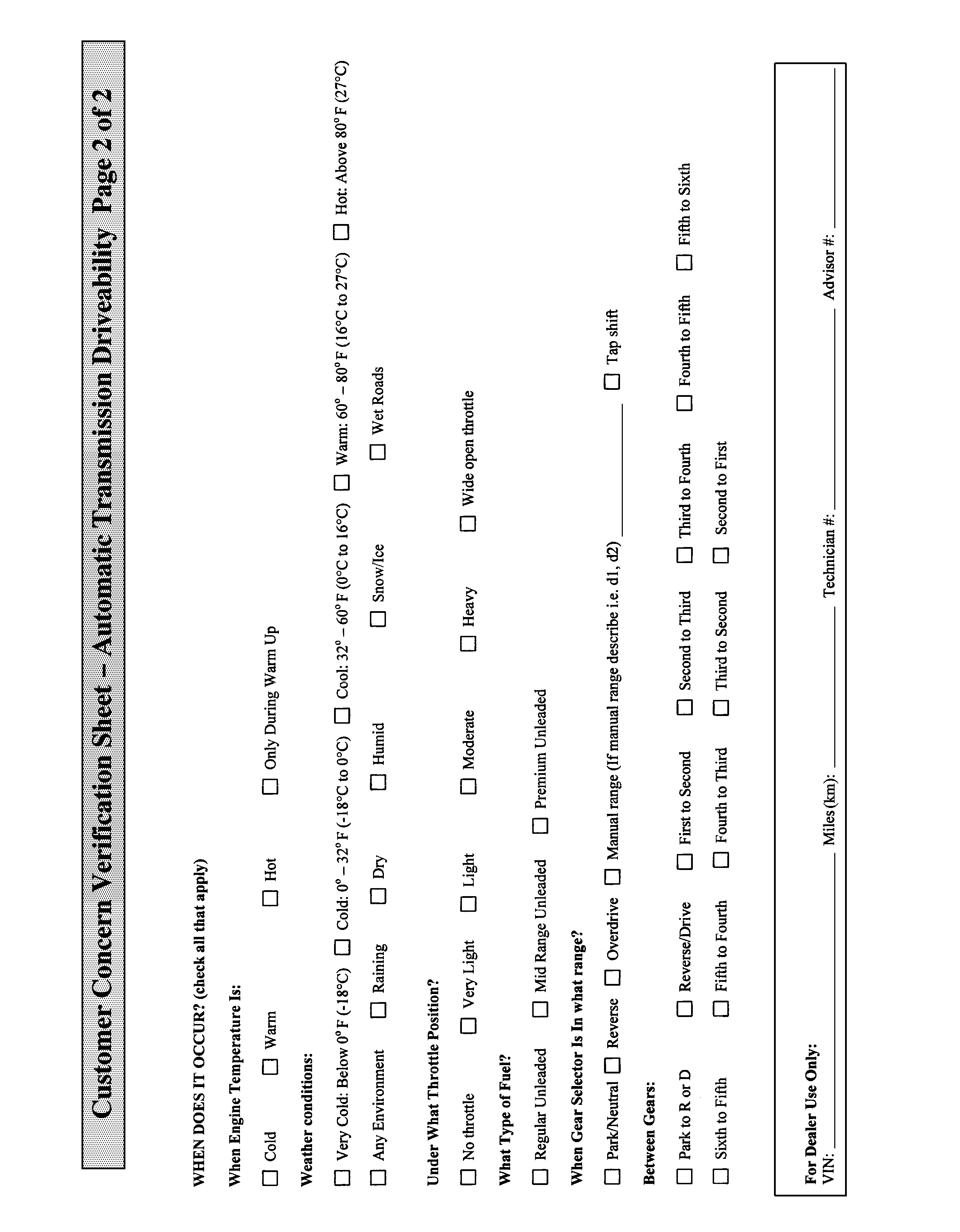
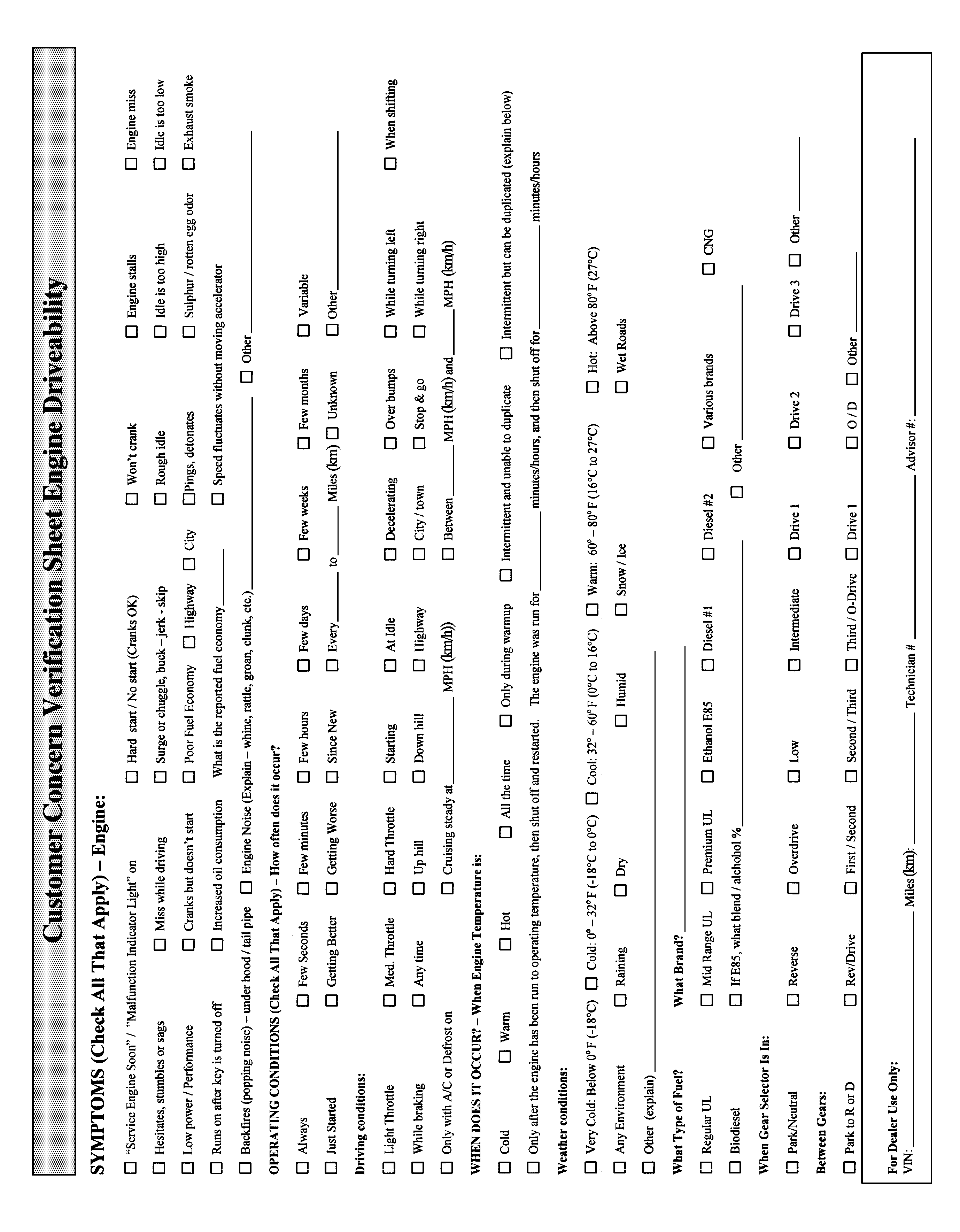
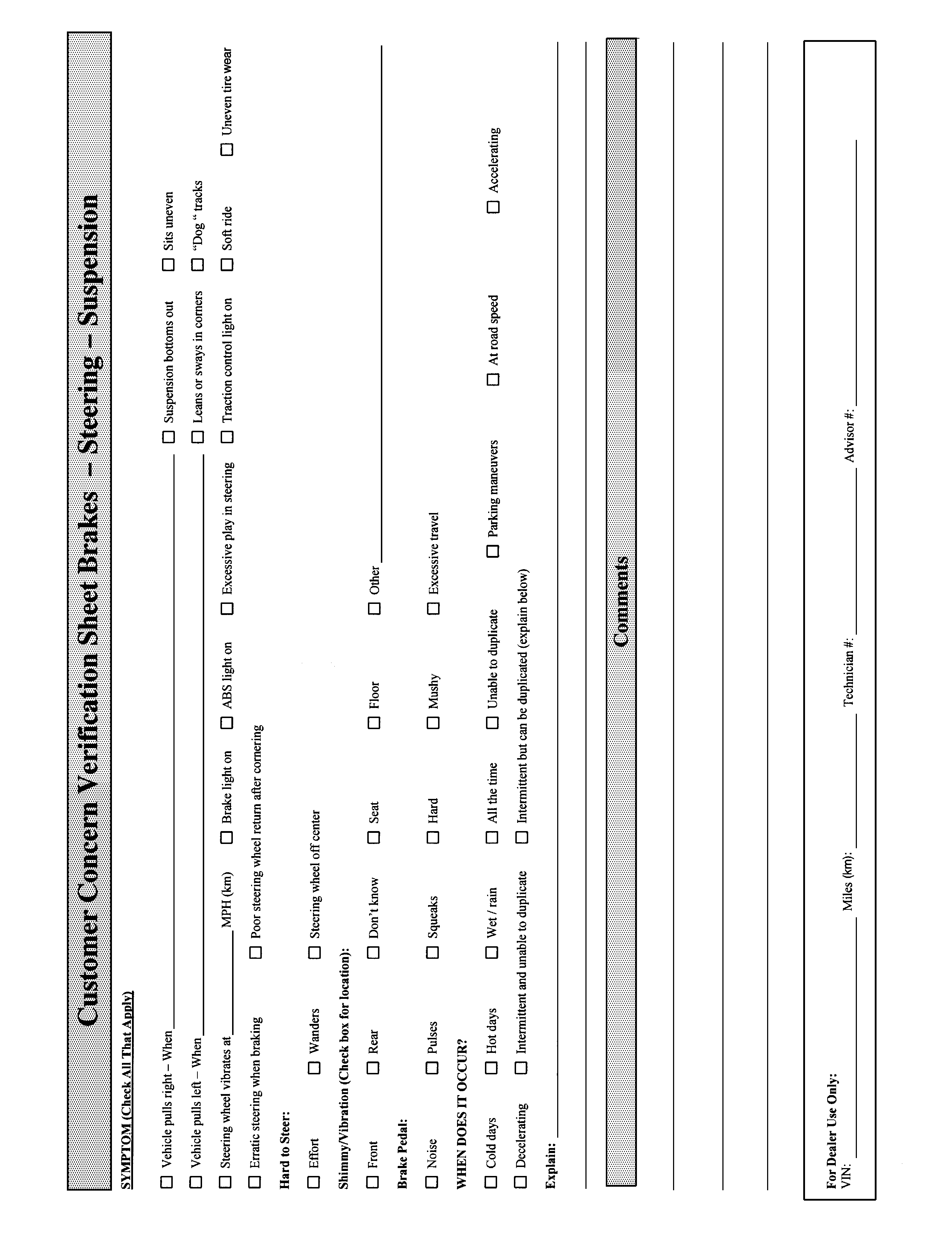
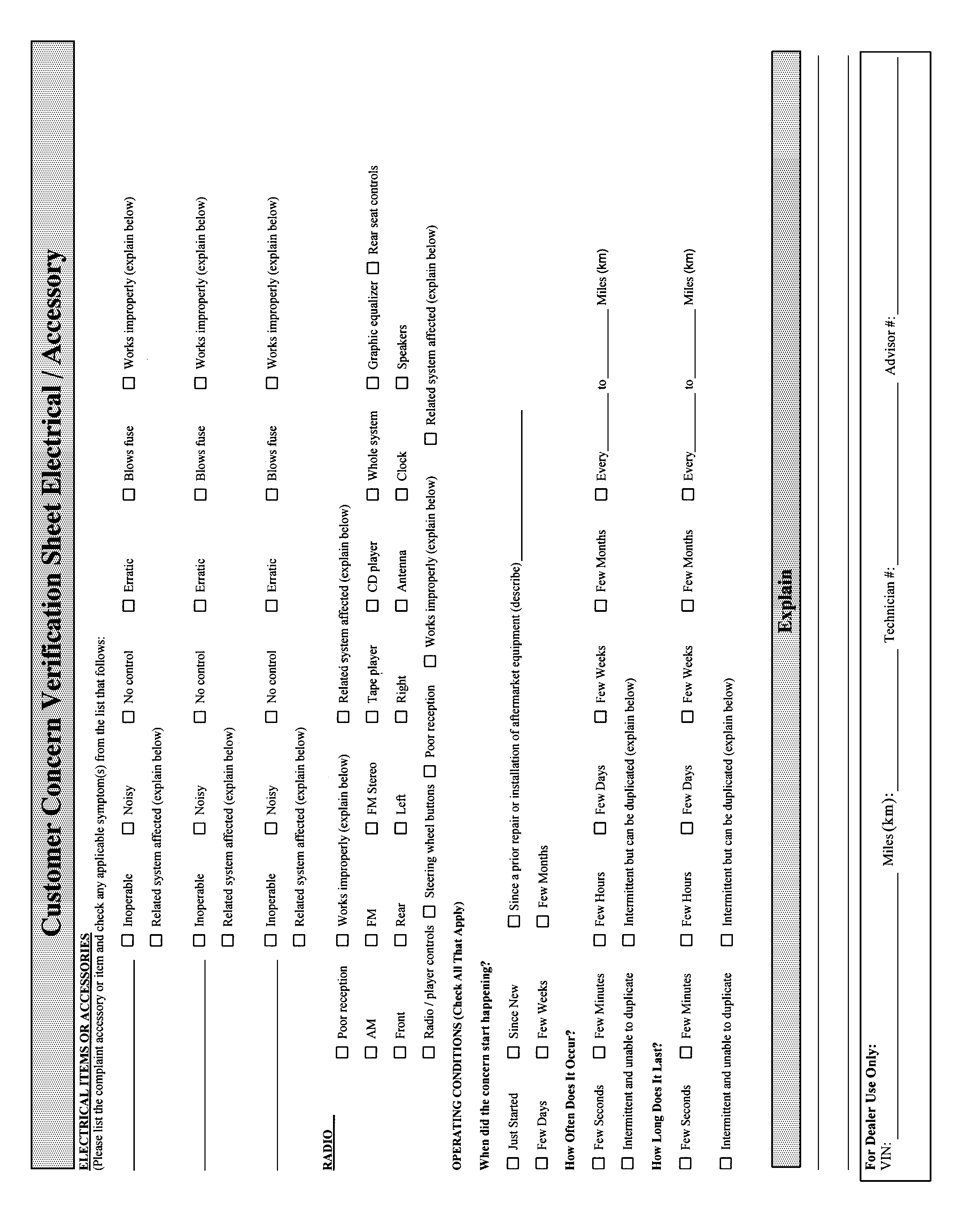
Comeback Prevention
Comebacks hurt your dealership's service image and the GM vehicle's brand image. We understand that due to ever-increasing vehicle complexity that this is a challenge. We suggest dealers focus on the following areas in order reduce comebacks:
| • | Communication |
| • | Repeat Repair logs |
| • | Quality control |
The Comeback Prevention flowchart summarizes "Best Practices" and should be utilized to help standardized work within the dealership as well as provide direction and appropriate use of research and diagnostic aids including TAC (See comeback prevention flowchart in this bulletin and also available in DealerWorld under the Service tab or on the Service & Body page of GMinfoNET for dealers in Canada).
On the first repair attempt:
| • | Always use the Comeback prevention flow chart. |
| • | Document and verify the customer concern. |
| • | Use GMVIS to review the vehicle repair history and to see open recalls. |
| • | Perform a repair if appropriate. |
| • | Inspect, repair and verify that the customer concern is resolved. |
| • | If the technician has not successfully found or isolated the concern, seek additional diagnostic help from Technical Assistance per the comeback prevention flow chart. |
On the second repair attempt:
| • | Always use the comeback prevention flow chart. |
| • | Enter into a Comeback Log. |
| • | Notify the shop foreman or other Service Management. |
| • | Repeat all checks and look for new service information (e.g. bulletins/PIs). |
| • | If the technician has not successfully found or isolated the concern, seek additional diagnostic help from Technical Assistance per the comeback prevention flow chart. |
| • | Perform a repair if appropriate. |
| • | Inspect, repair and verify that the customer concern is resolved. |
On the third repair attempt:
| • | Always use the comeback prevention flow chart. |
| • | Notify service management and the GM District Service Manager. |
| • | Repeat all checks and look for new service information (e.g. bulletins/PIs). |
| • | If the technician has not successfully found or isolated the concern, seek additional diagnostic help from Technical Assistance per the comeback prevention flow chart. |
| • | Perform a repair if appropriate. |
| • | Inspect, repair and verify that the customer concern is resolved. |
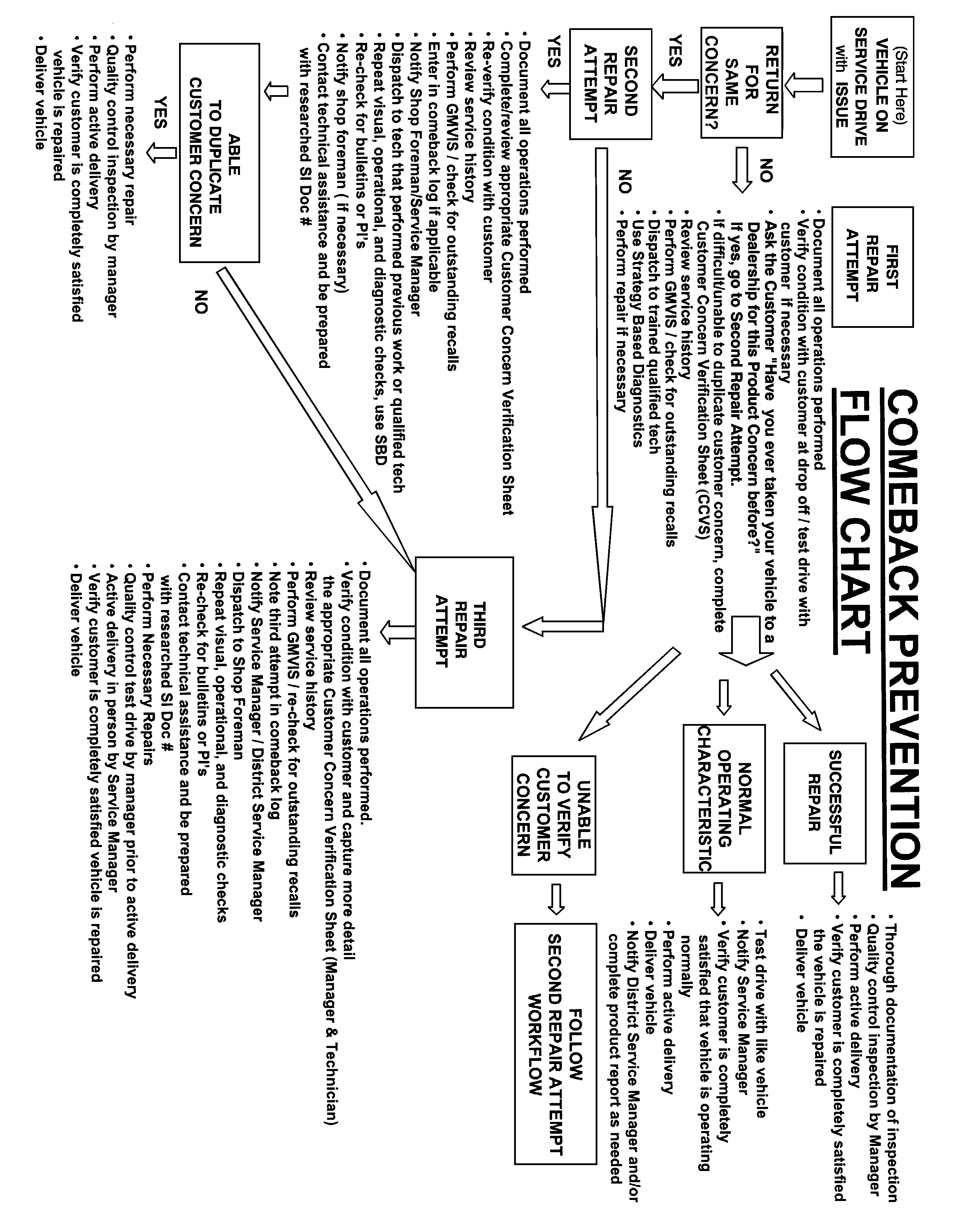
Repeat Repair Log
At the time of R.O. write up, Service Advisors should always ask the customer "Have you had repairs on any of these concerns before, even if the vehicle was taken to a different dealership?".
If the answer is Yes, Service Management must become involved and the R.O. needs to be flagged as "High Attention". The situation must be documented on the "Repeat Repair Log" (See attached form below and also available in DealerWorld under the Service tab). Dealers in Canada can also use the "Comeback Log (GMP418)" form located on the Service & Body page of GMinfoNET under Warranty Administration (forms).
Service Management must review Repeat Repair Logs weekly to spot trends and to develop and implement necessary corrective action plans.
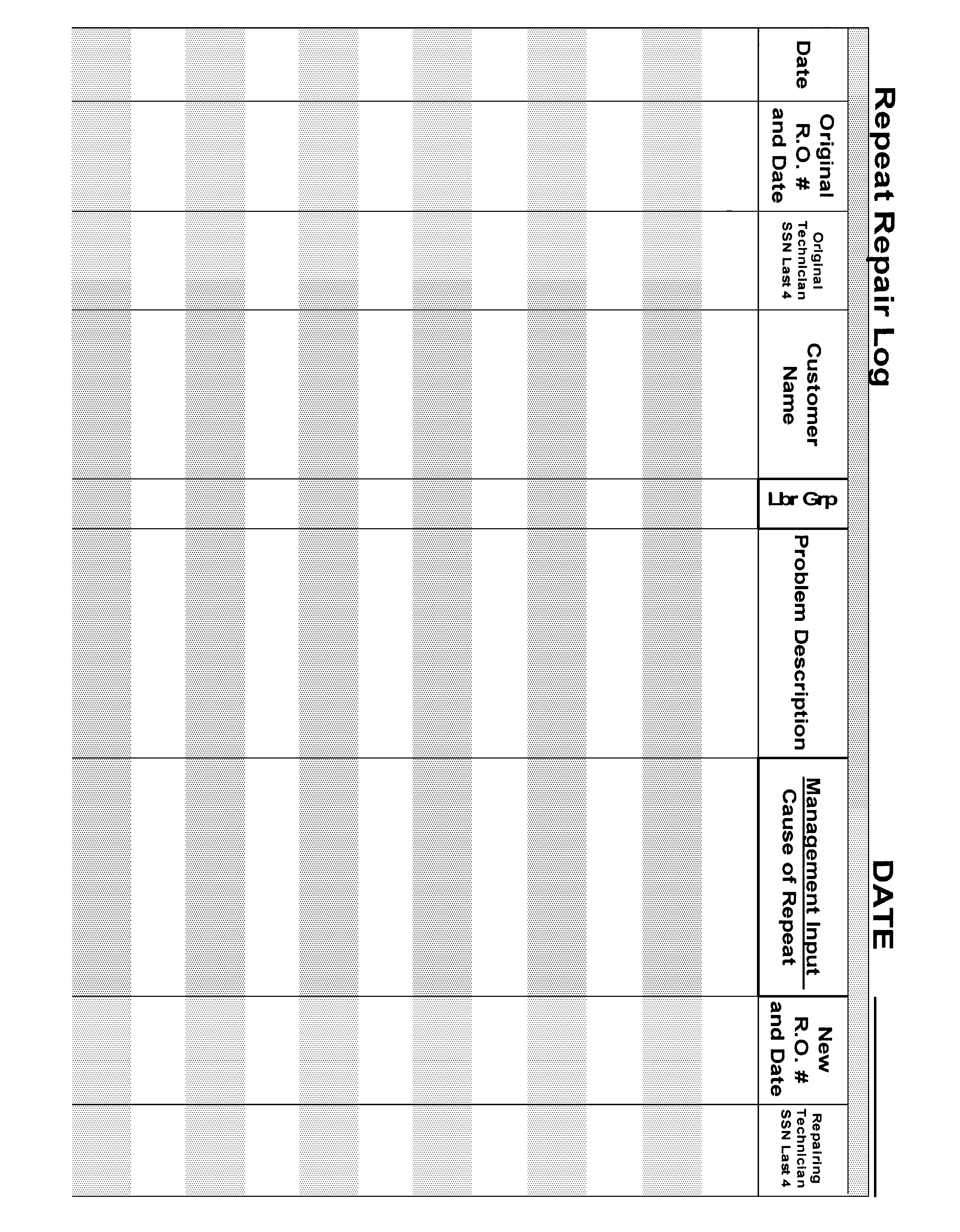
Best Practices Service Strategy
The Best Practices service strategy is an integral part of Comeback Prevention. This section has been updated to fully integrate TAC into your service practices, outlining WHEN and HOW to best utilize TAC to assist in documenting and performing lasting and proper repairs.
Important: GM TAC supports Current Model year products as well as the prior nine model years.
ALWAYS REFER TO THE CUSTOMER COMEBACK PREVENTION FLOW CHART FOR PROPER DETAILED SERVICE STRATEGY BEFORE PERFORMING ANY REPAIRS.
The following list HIGHLIGHTS the critical strategy elements outlined in the comeback flowchart that must be followed for EVERY Customer Service Event.
- Verify Customer Concern utilizing the Customer Concern Verification Sheets (shown above).
- Compare to a like vehicle. If the customer is dissatisfied due to a NORMAL OPERATING CHARACTERISTIC, create a Field Product Report (FPR) (Product Information Report (PIR) for Canadian dealers) and notify the DVM (DSM in Canada).
- Check the service history and research VIS. VERIFY THE NUMBER OF REPAIR ATTEMPTS FOR THE SAME ISSUE AND DAYS OUT OF SERVICE.
- Perform Strategy Based Diagnostics (DTC, SI, Recalls, PIs, Bulletins). If unable to duplicate concern, also refer to Corporate Bulletin Number 06-00-89-026.
- For parts delays and order issues, ensure that the Parts Manager has ordered as a CSO and upgraded to a SPAC case as quickly as possible. Canadian Saturn Saab retailers should contact Saturn Saab SWAT through GMTRACS.
- For parts catalog or service application issues, utilize ParTech to resolve the customer's concern as quickly as possible. ( U.S. Saturn retailers should contact the Saturn Parts Assistance Center and U.S. Saab dealers should contact the Parts HotLine.) Canadian Saturn Saab retailers should fax requests to ParTech Canada at 1-877-441-4985.
- For a second repair attempt, notify the Shop Foreman/Service Manager. After completing SBD, if additional diagnostic information is needed, call TAC with the above documentation and completed Technical Assistance Information Form (TAIF - shown later in this bulletin). Follow up with TAC until the vehicle is repaired, including RESULTS OF PREVIOUS DIAGNOSTIC RECOMMENDATIONS MADE BY TAC.
- For a third repair attempt for the same diagnostic issue, notify the Shop Foreman/Service Manager/DVM (DSM in Canada).
- If requested, close TAC case via DealerWorld or GMinfoNET with detailed repair information (refer to the instructions below).
- If requested, complete the TAC quality survey via DealerWorld or GMinfoNET (refer to the instructions below).
- Update Dealership TAC call log sheets after each call.
- Verify customer is completely satisfied that the vehicle is repaired.
| • | The upper portion of the Technical Assistance Information Form (TAIF - an example is shown later in this bulletin) is used to prepare your information about the vehicle prior to contacting Technical Assistance. Preparing for your call in advance will allow Technical Assistance personnel to reduce your call time and provide quality recommendations. In preparing this information, please refer to the Strategy Based Diagnosis section below. These diagnostic steps should be taken BEFORE you contact Technical Assistance. Doing so will assist you in completing the form. |
| • | Please check the Vehicle Information System (VIS) for prior service history. |
| • | The Electronic Case Closing (ECC) section should be accessed via DealerWorld or GMinfoNET to close a Technical Assistance case. The TAC Case Closing information is important because repair information that is loaded into our database can be used to repair other vehicles with the same concern. The more detailed the information, the more valuable it becomes. |
| • | The Quality Survey section should be accessed via DealerWorld or GMinfoNET. Completion of this survey provides TAC with your case feedback to improve the service we provide to dealerships. |
| • | The TAC Case Log Sheet should be kept by a phone designated for calling TAC. When calling TAC, you should log in the date of the call, your name, the TAC consultant's name, the repair order number, TAC case number and the date the case was closed. The TAC Case Log will allow you to maintain an accurate list of your open and closed TAC cases. |
| • | The General Motors Technical Assistance Center Phone Prompts are designed to get the caller to the appropriate group when calling. For U.S. dealers, A TAC phone prompt chart can be accessed via the DealerWorld Service tab and by selecting Service Forms. Recently, the phone prompts for U.S. TAC have undergone significant revisions to allow the technician to "speed prompt" to the appropriate diagnostic team and shorten the amount of time it takes to reach a TAC consultant. The most up-to-date phone prompt guide for U.S. TAC is available in DealerWorld under the Service tab. |
Strategy Based Diagnosis
The goal of Strategy Based Diagnosis is to provide guidance when you create a plan of action for each specific diagnostic situation. Following a similar plan for each diagnostic situation, you will achieve maximum efficiency when you diagnose and repair vehicles. Although each of the Strategy Based Diagnosis boxes is numbered, you are not required to complete every box in order to successfully diagnose a customer concern. The first step of your diagnostic process should always be Understand and Verify the Customer's Concern. The final step of your diagnostic process should be Repair and verify the Fix. Refer to the following chart for the correct Strategy Based Diagnosis.
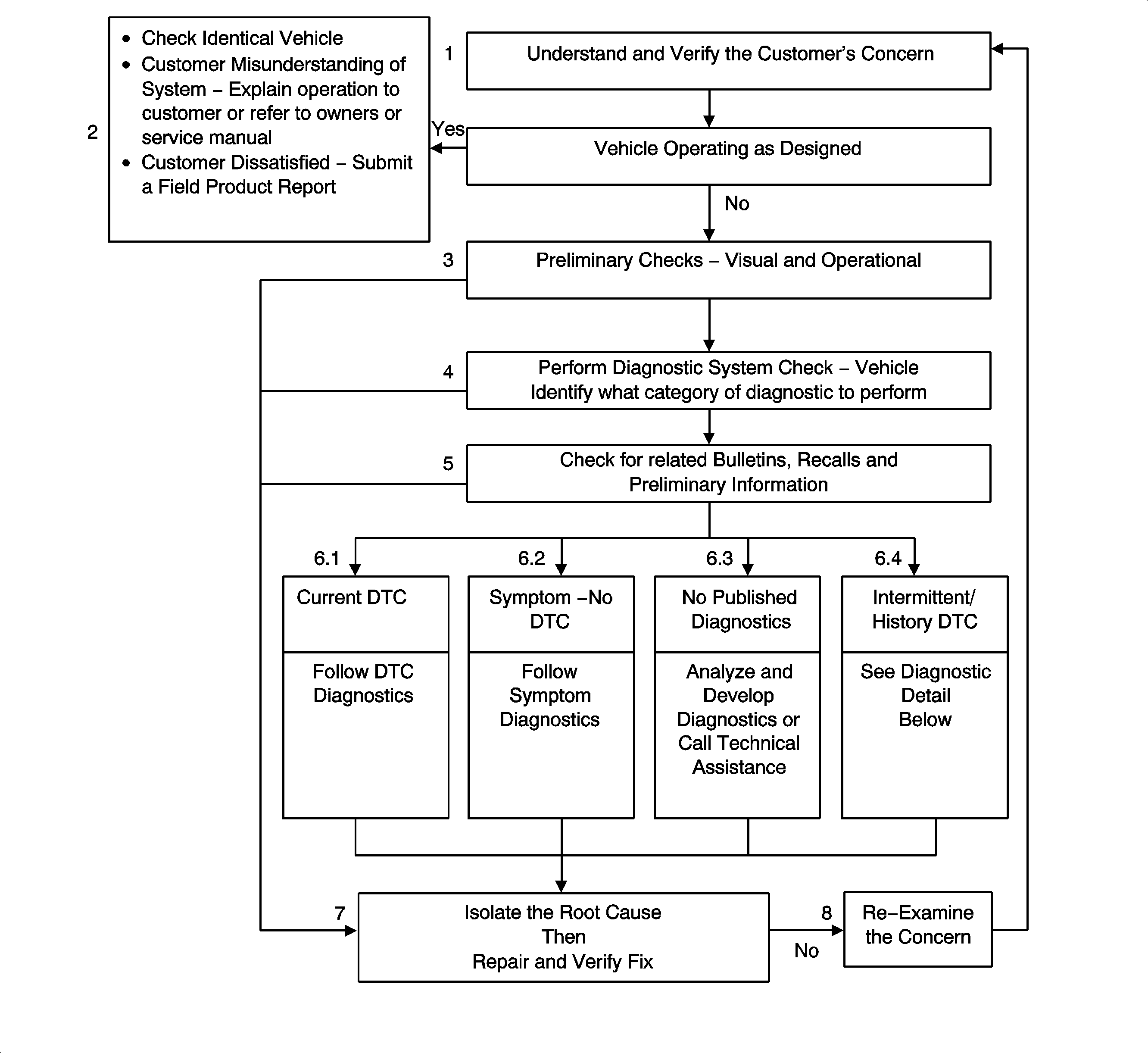
- Understand and Verify the Customer's Concern: The first part of this step is to obtain as much information as possible from the customer. Are there aftermarket accessories on the vehicle? When does the condition occur? Where does the condition occur? How long does the condition last? How often does the condition occur? In order to verify the concern, the technician should be familiar with the normal operation of the system and refer to the owner or service manual for any information needed.
- Vehicle Operating as Designed: This condition exists when the vehicle is found to operate normally. The condition described by the customer may be normal. Compare with another like vehicle that is operating normally under the same conditions described by the customer. Explain your findings and the operation of the system to the customer. If the customer is dissatisfied submit a Field Product Report.
- Preliminary Checks: Conduct a thorough visual inspection. Review the service history. Detect unusual sounds or odors. Gather diagnostic trouble code (DTC) information in order to achieve an effective repair.
- Perform Published Diagnostic System Check- Vehicle: The Diagnostic System Check - Vehicle verifies the proper operation of the system. This will lead the technician in an organized approach to diagnostics and identify what category of diagnostic to perform.
- Check for related Bulletins, Recalls and Preliminary Information (PI).
- Diagnostic categories:
- Isolate the Root Cause then Repair and Verify Fix: After isolating the root cause, make the repairs and validate for the correct operation by performing the Diagnostic Repair Verification. Verifying that the DTC or symptom has been corrected may involve road testing the vehicle.
- Re-examine the Concern: If a technician cannot successfully find or isolate the concern, a re-evaluation is necessary. Re-verify the concern. The concern could be an intermittent or normal condition.
| 6.1. | Current DTC: Follow the designated DTC diagnostic in order to make an effective repair. Refer to Diagnostic Trouble Code (DTC) List - Vehicle. |
| 6.2. | Symptom - No DTC: Select the appropriate symptom diagnostic. Follow the diagnostic steps or suggestions in order to complete the repair. Refer to Symptoms - Vehicle. |
| 6.3. | No Published Diagnostics: Analyze the Concern. Develop a plan for the diagnostics. The service manual schematics will help you to see system power, ground, input, and output circuits. You can also identify splices and other areas where multiple circuits are tied together. Look at component locations to see if components, connectors or harnesses may be exposed to extreme temperature, moisture, or corrosives (road salt, battery acid, oil or other fluids). Utilize the wiring diagrams, system description and operation, and system circuit description. |
| 6.4. | Intermittent/History DTC: An intermittent condition is one that does not occur continuously, may be difficult to duplicate, and will only occur when certain conditions are met. Generally, an intermittent is caused by faulty electrical connections and wiring, malfunctioning components, electromagnetic/radio frequency interference, driving conditions, or aftermarket equipment. The following approaches/tools may prove to be beneficial in locating and repairing an intermittent condition or history DTC. |
| • | Combining technicians knowledge with the available service information. |
| • | Evaluate the symptoms and conditions described by the customer on the Customer Concern Verification Sheets. |
| • | Follow the suggestions on Testing for Intermittent Conditions and Poor Connections. |
| • | Use the available scan tool, digital multi-meter, or J 42598 with data capturing capabilities. |
Technical Assistance Information Form | |
|---|---|
Questions to Answer Prior to Contacting Technical Assistance | |
Caller Name:
Dealer Code:
VIN:
R.O. Number:
Mileage:
__________ What is the number of times this vehicle has been to your dealership for the same condition?
__________ How many days has this vehicle been in your dealership for this condition?
Please check the Vehicle Information System (VIS) for prior service history.
Does this vehicle have any GM or non-GM aftermarket accessories, or has it been modified from production? Yes/No __________ If yes, please list:
What is the customer's concern (why did the customer bring their vehicle to your dealership)?
SI Document Number (SI Document #, Service Manual page, Owner Manual page, Bulletin Number, wiring schematic, IRIS, WIS):
What are the results of your Strategy Based Diagnostics (i.e. concern duplicated? when does the condition occur? diagnostics performed? DTCs? compared to like vehicle? parts replaced?):
Tech 2 software version (if applicable):
TAC Case No. (fill in after call):
TAC Consultant's Name:
| |
TAC Suggested Action:
| |
TAC Case Closing Information: Please utilize the Electronic TAC Case Closing Form located on the DealerWorld Service tab (in Canada, provide input to close TAC active cases located on GMinfoNET). Please provide detail in the case closing. In the technician's own words, what fixed the vehicle? Be specific - include circuit and terminal numbers, locations, part name and numbers):
Refer to the example below. | |
TAC Dealer Survey - Technician Only
We would like your feedback on the assistance you received. To assure quality improvements, it is important that only the related technician for this repair complete this survey. Please utilize the Electronic TAC Quality Survey located on the DealerWorld Service tab or on the Service & Body page of GMinfoNET for dealers in Canada.
Refer to the example below. |
Example of TAC Case Closing (1 of 2) (U.S. form shown)

